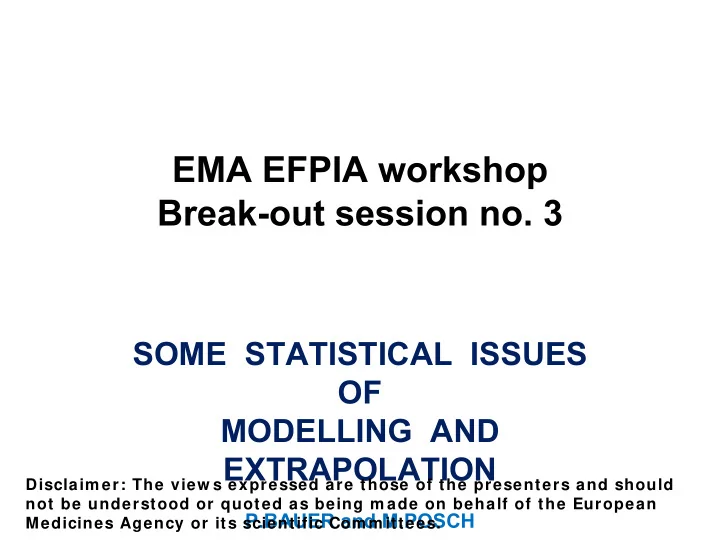

EMA EFPIA workshop Break-out session no. 3 SOME STATISTICAL ISSUES OF MODELLING AND EXTRAPOLATION Disclaim er: The view s expressed are those of the presenters and should not be understood or quoted as being m ade on behalf of the European P.BAUER and M.POSCH Medicines Agency or its scientific Com m ittees.
Background & Rationale The following is laid down in the planning phase for a study in a subpopulation (e.g., for a clinical study in children within a P aediatric I nvestigation P lan) : “A one-sided significance level of 0.1 is applied for the statistical test of the primary outcome variable.” (One-sided significance levels up to 0.25 have been seen in the PDCO!)
What has that to do with extrapolation? The more liberal significance level seems to be justified scientifically and ethically since before starting trials in paediatric subpopulations usually evidence is already existing from adults (or also from children in higher ages) Hence the controlled trial proposed in the PIP can be seen as a validation study to “safeguard” for the possibility that the extrapolation paradigm does not hold. (Not applying the two pivotal study paradigm is already some sort of extrapolation) In our example extrapolation (bridging) is formalized by enlarging the level for the type I error rate (borrowing strength from evidence in other populations) !
Performing the study at level γ (e.g.=0.1) If the extrapolation paradigm does not hold ( the treatment does not work in the subpopulation ) the risk of a false positive decision from the validation study remains as high as the significance level γ (=0.1) chosen for the validation study ! When and by which arguments may such a significance level be justified?
The Scepticism Factor s The Scepticism Factor s is the “probability” that the treatment is not effective in the sub-population, i.e. that the extrapolation assumption is incorrect. Frequentist interpretation long-run proportion of similar settings where the extrapolation assumption is incorrect Bayesian interpretation prior probability on the null hypothesis in the subpopulation The Scepticism Factor is quantified by expert opinions or, e.g., M&S.
The Long Run Proportion of False Positive Decisions If the significance level γ is applied, the False Positive Report Probability (FPRP) is given by α * = γ ·s ( Wacholder et al. ‘04) Note: To control the FPRP among all subpopulation decisions in similar settings by α * (e.g., α * =0.025) the significance level of the validation study γ has to be set to γ = α * /s
Some properties γ = α * /s + The “scepticism” in case of extrapolation to (paediatric) subgroups (due to existing evidence in the adult population) generally should be smaller than in the usual Phase III s i t u a t i o n ! + If the “scepticism” is very small, e.g., s < α * (= 0.025), no study would be required since the significance level γ exceeds 1! PDCO decision: extrapolation of efficacy without clinical studies in children Sometimes only “case series of x patients” are requested for subpopulations + If there is very strong scepticism s=1 a study with full
The significance level, the sample size and the posterior probabilities as a function of scepticism s Two parallel balanced groups (treatment versus control), normal distribution, common known variance, z-test Given: F alse P ositive R eport P robability α * =0.025, 0.000625 (=0.025 x 0.025) Power (1- β ) = 0.8, 0.95 To be determined: Significance level of the subgroup validation study γ Relative sample size ( ≤ 1) as compared to a trial with significance level α * Smallest posterior probability on the alternative corresponding to a rejection of the null hypothesis in the test of the validation study at level
No study ϒ =0.5 ( observed effect > 0) Criterion for homogeneity over trial subpopulations? ϒ =0.025 2 α *
β * = = C orrect P ositive R eport P robability
s=0.5, γ = β =0.05 Posterior > 0.5
In very large studies here the relationship is highly variable
Concluding Remarks • The use of relaxed significance levels for testing the primary outcome variable in subpopulations is asked for, e.g., in PIPs. Although intuitively appealing sufficient justification is difficult • It has been tried to provide some „formal“ link of extrapolation to the relaxation of significance levels in subgroup validation studies • It also has been tried to bridge test decisions based on increased type I error rates to Bayesian decision criteria • The arguments given may add some understanding of delicate decisions under uncertainty. • However, justification of extrapolation remains l i f b d t ti ti
Recommend
More recommend